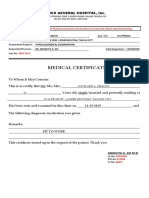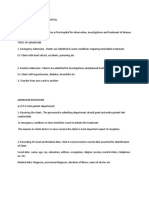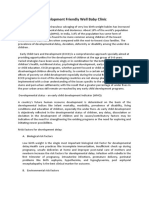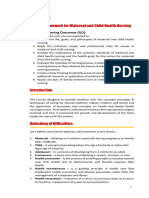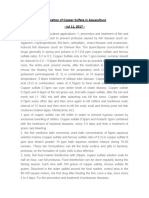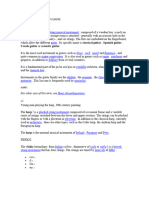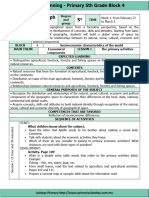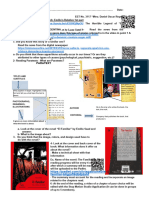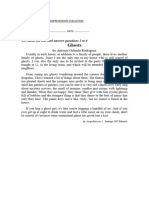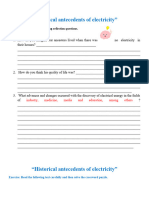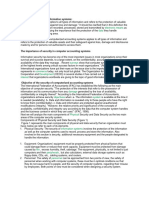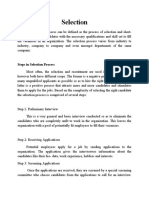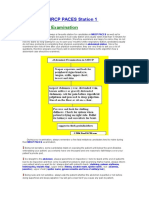CCRED Educational Session Plan
CCRED Educational Session Plan
Uploaded by
ScribdTranslationsCopyright:
Available Formats
CCRED Educational Session Plan
CCRED Educational Session Plan
Uploaded by
ScribdTranslationsOriginal Description:
Copyright
Available Formats
Share this document
Did you find this document useful?
Is this content inappropriate?
Copyright:
Available Formats
CCRED Educational Session Plan
CCRED Educational Session Plan
Uploaded by
ScribdTranslationsCopyright:
Available Formats
GROWTH AND DEVELOPMENT CONTROL
EDUCATIONAL SESSION PLAN
I. GENERAL DATA:
I.1. Topic: “Importance of growth and development control”
I.2. Location: IEP Hosanna
I.3. Time: 6:00 PM
I.4. To whom it is addressed: To the parents of the IEP Hosanna
I.5. Responsible: The students of the VII cycle of the nursing school
I.6. Theme motto: ''Growing and Developing with our children''
II. JUSTIFICATION
Early childhood is a fundamental stage in the growth and development of every
human being. Growth and development are interdependent and its most critical
stage occurs between conception and the first years of life, a time in which the
brain forms and develops at maximum speed. If the proper development of the
brain is altered during these periods, consequences will occur that will affect
the boy and girl throughout their life.
The comprehensive development of childhood is fundamental for human
development and the construction of social capital, elements considered main
and necessary to break the cycle of poverty and reduce inequality gaps and
growth is expressed in the increase in weight and height. and development is
defined as changes in physical and neurological, cognitive and behavioral
structures, which emerge in an orderly manner and are relatively long-lasting.
In this context, it is of singular importance to monitor the growth and
development of girls and boys with the aim of improving their integral
development through the early detection of risks, alterations or disorders of
these processes, for their timely attention as well as promoting appropriate care
and upbringing practices at the family and community level. That is why the
Peruvian government, in 1996, approved the use of
That is why this work explains the importance of controlling the child's growth
and development.
Nursing in child and adolescent health 1
GROWTH AND DEVELOPMENT CONTROL
III. GOALS
III.1. GENERAL
Through this talk, we seek to inform mothers about the importance
of growth and development through an educational session
provided by the students of group “A” of the VII cycle of the nursing
school.
III.2. SPECIFICS
Explain to parents the definition of CRED
Raise awareness of the importance of growth and
development control
Inform the nurse in the control of growth and development
IV. CONTENT
"GROWTH AND DEVELOPMENT CONTROL"
The Ministry of Health (MINSA) through all its establishments nationwide considers
Growth and Development Control (CRED) as a very important preventive activity,
as it ensures the optimal development of girls and boys under 05 years of age. In
this sense, MINSA has made important efforts to improve the comprehensive offer
of services and satisfy the demand of the child population.
1) DEFINITION:
Periodic and systematic activities developed by the nursing professional, with the
objective of adequately and timely monitoring the growth and development of girls
and boys under 5 years of age in order to detect early and timely risks, alterations
or disorders, as well as the presence of diseases, facilitating their diagnosis and
treatment, and thus reducing the severity and duration of the alteration, avoiding
sequelae, reducing disability and preventing death.
The first years of human life are highly transcendent, because at this stage the
greatest speed of growth and development of the brain occurs. If situations occur
during these periods that alter brain development, the child's abilities will be
Nursing in child and adolescent health 2
GROWTH AND DEVELOPMENT CONTROL
significantly affected. Therefore, monitoring the child in these early years is one of
the most effective strategies to promote adequate growth and development and
ensure the development of these capacities.
During the growth and development control of the girl or boy under 5 years of age,
risks are detected in a timely manner and determining factors are identified, to
prevent problems in growth and development and promote appropriate care
practices for the girl and boy. To do this, the health provider uses interviews,
observations, clinical examinations, anamnesis, among others. This information is
recorded in the medical history.
Monitoring of the growth and development of the girl and boy is done individually,
comprehensively, timely, periodically and sequentially.
It is individual, because each child is a being, with its own specific
characteristics, therefore it must be seen from its own context and
environment.
It is comprehensive because it addresses all aspects of growth and
development, that is, the health, psychoaffective development and nutrition
of the child.
It is timely when monitoring is carried out at the key moment to evaluate
their growth and development, which corresponds to their age.
It is periodic, because it must be carried out according to a schedule
established individually and according to the age of the girl or boy.
It is sequential, because each current control must be related to the
previous control, observing progress in growth and development, especially
in periods considered critical.
2) THE IMPORTANCE
With CRED controls, parents can monitor the growth and development of their
minor children because it allows them to identify, in a timely manner, risk
situations such as whether they are at their height and weight for their age or if
they are at risk of fall into chronic malnutrition, among others. In addition, health
personnel can identify alterations in growth, detect the presence of diseases in
a timely manner, facilitating their diagnosis and rapid intervention.
In CRED controls, physical examinations are performed on children,
assessments of growth and nutritional status, detection of prevalent diseases,
visual, hearing, oral health problems, and signs of violence or abuse. Also, they
receive doses of vaccines that will help them be protected. And parents receive
free micronutrients with which they can prevent anemia.
Nursing in child and adolescent health 3
GROWTH AND DEVELOPMENT CONTROL
3) ACTIVITIES:
Monitoring the growth and development of children under 5 years of age
includes the following activities:
a) Preparation and monitoring of the individualized health care plan.
Evaluation of:
o Health status (Detection of prevalent diseases).
o Growth and nutritional status.
o Psychomotor development.
b) Identification of factors that determine the health, nutrition, growth,
development and upbringing of girls and boys.
o Food consumption.
o Compliance with the vaccination schedule. c) Detection of
cases of family violence and child abuse.
c) Comprehensive counseling according to the child's age and findings.
d) Guidelines for stimulating the development and comprehensive care of
the child according to their age.
e) Record..
4) ROLE OF THE CRED NURSE
The CRED nurse is responsible for promoting the physical and emotional health of
the child, as well as preventing diseases that alter their growth and development,
which is based on comprehensive care considering the child as a biopsychosocial
being, this is evident in the basic services package. comprehensive child care.
The nurse develops with skill and skill procedures typical of the CRED office for the
care of a healthy child (physical examination, assessment of growth and
psychomotor development), guides the mother, and resolves any questions. It
should be considered that the waiting time for the consultation should not last more
than 30 to 60 minutes and the duration of the consultation should be approximately
15 to 30 minutes; However, it must be taken into account that this may vary
according to the demand and need of the child, since a developmental evaluation
according to the Brief Guideline will be in a short time, unlike the use of the EEDP
in children under 2 years of age and TEPSI in children from 2 to 5 years old.
Nursing in child and adolescent health 4
GROWTH AND DEVELOPMENT CONTROL
Furthermore, the nurse has, in particular, knowledge and theoretical bases that
consider people's values and beliefs as essential to establish a helping relationship
that allows intervention and, in this case, education.
V. METHODOLOGY
Exhibitor
Dynamic
Participatory
Asset
Dialogue
VI. SCHEDULE
Contents Activities Technique
Educationa Durati
and s and
Responsible Family l materials on
objectives methods
The attending
Medium:
The nursing parent users Method:
Auditory,
GREETING students greet the respond Dialogue 2’
spoken
attending parents. assertively to the
word
greeting.
The nursing The participants
students introduce mention the topic
spoken Active -
themselves to the of the educational
word participator
PRESENTAT mothers and ask session through
y 4’
ION questions so that the resolution of
Brainstormi
they can infer the the questions
ng. Dialogue
topic of the asked by the
educational session. nursing students.
Method:
Parents who use Participato
Educational the Service Gigantograp ry asset
Students begin the 10’
session itself collaborate and hy
educational session
attend attentively. .
Students deliver a The participants Triptych.
brochure on the receive and
Written
FEEDBACK topic, making a curiously review Asset. 3’
word.
summary in a clear the material
voice. delivered. spoken
Nursing in child and adolescent health 5
GROWTH AND DEVELOPMENT CONTROL
word
The students of
Spoken
Farewell, nurses will thank the Participants
word. Technique:
thanks and parents. And it will register on the 3’
Written dialogue
registration. proceed to sheet provided.
word.
registration.
VII. RESOURCES AND MATERIALS:
VII.1. Material resources
Cardboards
images
Markers
Scissors
Eraser
colored paper
Pencil
Draft
Sharpener
Images of hand washing steps
Gigantography on HAND WASHING
Participation record
VII.2. Human Resources
VII cycle nursing students
Parents attending the IEP HOSANNA school
Lic. Child and adolescent health nursing supervisor
VII.3. Institutional resources
IEP HOSANNA
VIII. ASSESSMENT:
The evaluation will be at the end, open questions will be asked about
the specific points of the topic that has been discussed to make it
dynamic and participatory and provide ideas "brainstorming" about what
they have understood.
Nursing in child and adolescent health 6
GROWTH AND DEVELOPMENT CONTROL
Achieve and guarantee that all family members are clear about the
importance of “Control of growth and development” whose answers will
indicate the degree of uptake and whether the stated objective was a
success.
IX. BIBLIOGRAPHY:
Sánchez, S. I. (2013). Percepción de las madres acerca de la calidad de atención que brinda la
enfermera en el consultorio de cred de la red de EsSalud “San José” - 2012 . UNIVERSIDAD
NACIONAL MAYOR DE SAN MARCOS , Lima . Obtenido de
http://cybertesis.unmsm.edu.pe/bitstream/handle/cybertesis/1040/Guevara_ss.pdf?
sequence=1
X. ANNEXES:
SAN PEDRO UNIVERSITY
PROFESSIONAL SCHOOL OF NURSING
Nursing in child and adolescent health 7
GROWTH AND DEVELOPMENT CONTROL
REGISTRATION OF PARTICIPATION IN THE EDUCATIONAL SESSION ON
“IMPORTANCE OF GROWTH AND DEVELOPMENT CONTROL”
INSTITUTION:………………………………………………………………………
RESPONSIBLE:……………………………………………………………………
LIC. WHAT SUPERVISES:
……………………………………………………………………
DATE:………………………………………………………………………………
N NAMES AND SURNAMES ID SIGNATURE
o.
Nursing in child and adolescent health 8
You might also like
- FFFFDocument9 pagesFFFFJoyce Ann LemosNo ratings yet
- BUDGET PLAN Medical MissionDocument4 pagesBUDGET PLAN Medical MissionWinona Marie Dohig Baquial88% (8)
- ECCE Notes PDFDocument11 pagesECCE Notes PDFshafNo ratings yet
- Admission of Client To HospitalDocument6 pagesAdmission of Client To HospitalSandeep Kumar100% (1)
- ECCD LOGO - STANDARDS AND GUIDELINES v4Document60 pagesECCD LOGO - STANDARDS AND GUIDELINES v4Fritz Maguinda67% (3)
- Enriquez, Mary Grace M. - Summative AssessmentDocument10 pagesEnriquez, Mary Grace M. - Summative AssessmentMary Grace Manata EnriquezNo ratings yet
- Soap Note 2 Dominguez 2015Document5 pagesSoap Note 2 Dominguez 2015api-320062911No ratings yet
- College of of Midwifery I. Course Name: Early Childhood Care II. Course OverviewDocument43 pagesCollege of of Midwifery I. Course Name: Early Childhood Care II. Course OverviewmelpayangsNo ratings yet
- LESSON 1.1 Maternal AND CHILDDocument11 pagesLESSON 1.1 Maternal AND CHILDAbegail Dapulag AdrayanNo ratings yet
- ECD National Strategy Proof Read 13022017 EN PDFDocument37 pagesECD National Strategy Proof Read 13022017 EN PDFAbdulkadir NuhNo ratings yet
- Early Childhood DevelopmentDocument15 pagesEarly Childhood DevelopmentAnika TasnimNo ratings yet
- Preventive PediatricsDocument107 pagesPreventive Pediatricskrishnasree100% (2)
- Analysis of Child Development Based On Development Psychological TheoryDocument8 pagesAnalysis of Child Development Based On Development Psychological TheoryJournal of Education and LearningNo ratings yet
- اهمية_متابعة_تطور_نمو_الأطفال_في_مراكز_الرعاية_الصحية_الأولية_Document21 pagesاهمية_متابعة_تطور_نمو_الأطفال_في_مراكز_الرعاية_الصحية_الأولية_wamdacoolNo ratings yet
- Unit 2: CYP Core 3.2: Promote Child and Young Person Development R/601/1694Document4 pagesUnit 2: CYP Core 3.2: Promote Child and Young Person Development R/601/1694Garima SinghNo ratings yet
- Chandrakant Development Friendly Wel Baby ClinicDocument4 pagesChandrakant Development Friendly Wel Baby Clinicapi-228136529No ratings yet
- Kalusugan NG Bata Pahalagahan - Outreach Program For ChildrenDocument25 pagesKalusugan NG Bata Pahalagahan - Outreach Program For ChildrenKimberly AcolNo ratings yet
- MCN FINALS MergedDocument193 pagesMCN FINALS MergedNeru RoriNo ratings yet
- Developmental Assessment FinalDocument13 pagesDevelopmental Assessment FinalGabriel Robs LunguNo ratings yet
- Module Six Resource GuideDocument28 pagesModule Six Resource Guidejade tagabNo ratings yet
- MCN 3Document32 pagesMCN 3Rainy Days100% (2)
- ECE 002 Module 01Document8 pagesECE 002 Module 01Yesha GomezNo ratings yet
- A Guide For Monitoring Child Development PDFDocument11 pagesA Guide For Monitoring Child Development PDFneutralna0% (1)
- NCM 107 - Care of Mother, Child, and Adolescents (Well Clients) - ContentDocument91 pagesNCM 107 - Care of Mother, Child, and Adolescents (Well Clients) - ContentFrancine Kaye BedicoNo ratings yet
- Pemahaman Siswa Mengenai Kesehatan Reproduksi Remaja Melalui Layanan InformasiDocument10 pagesPemahaman Siswa Mengenai Kesehatan Reproduksi Remaja Melalui Layanan InformasiMayaApaneMayolNo ratings yet
- Introductory Concept of Pediatric NursingDocument21 pagesIntroductory Concept of Pediatric Nursingacuna27cielsiNo ratings yet
- Lec 3 5th 2020Document11 pagesLec 3 5th 2020Sajad AliraqinnnNo ratings yet
- Health Promotion and Education in School - VL PDFDocument28 pagesHealth Promotion and Education in School - VL PDFAshu AmmuNo ratings yet
- The Practice of The NursingDocument3 pagesThe Practice of The NursingInternational Journal of Innovative Science and Research TechnologyNo ratings yet
- Jurnal Yenita SariDocument6 pagesJurnal Yenita SariYenita sariNo ratings yet
- N 313 Peds Syllabus Part 2 Fall 2011Document5 pagesN 313 Peds Syllabus Part 2 Fall 2011bmccsnresourcesNo ratings yet
- AEP - Teachers WorkbookDocument211 pagesAEP - Teachers Workbooksudharamalingam100% (1)
- Executive Summary Lancet Special Series ECD 2016Document8 pagesExecutive Summary Lancet Special Series ECD 2016Tirtharaj DhunganaNo ratings yet
- Annals of The New York Academy of Sciences - 2018 - Britto - What Implementation Evidence Matters Scaling Up NurturingDocument12 pagesAnnals of The New York Academy of Sciences - 2018 - Britto - What Implementation Evidence Matters Scaling Up NurturingCarle Mae SanquinaNo ratings yet
- NCM 101 GuideDocument78 pagesNCM 101 GuideTimi BCNo ratings yet
- HealthDocument18 pagesHealtharavindkt.pearlNo ratings yet
- Growth ChartDocument12 pagesGrowth ChartT. Chang100% (2)
- Enriquez, Mary Grace M. - Summative AssessmentDocument10 pagesEnriquez, Mary Grace M. - Summative AssessmentMary Grace Manata EnriquezNo ratings yet
- Child Development in UAEDocument6 pagesChild Development in UAEkelvin fabichichiNo ratings yet
- Health and Education Interdependence: Thriving From Birth To AdulthoodDocument340 pagesHealth and Education Interdependence: Thriving From Birth To Adulthoodmit6pavelNo ratings yet
- Pengetahuan Kader Meningkatkan Motivasi Dalam Melakukan Deteksi Dini Tumbuh Kembang BalitaDocument6 pagesPengetahuan Kader Meningkatkan Motivasi Dalam Melakukan Deteksi Dini Tumbuh Kembang BalitaAizil WahyuniNo ratings yet
- The Philosophy of Health EducationDocument16 pagesThe Philosophy of Health EducationTelet TolentinoNo ratings yet
- Assignment Solution 8610Document16 pagesAssignment Solution 8610Haroon Karim BalochNo ratings yet
- Unit 1 ECCEDocument16 pagesUnit 1 ECCEAlmost ChristinaNo ratings yet
- Eced 21 Lesson2Document32 pagesEced 21 Lesson2Joanna Mae MendozaNo ratings yet
- CBSE School Health PolicyDocument12 pagesCBSE School Health Policydheeraj_c100% (3)
- Human Development N LearningDocument15 pagesHuman Development N LearningAsad NomanNo ratings yet
- Focus On Child Health PDFDocument28 pagesFocus On Child Health PDFAbhishekNo ratings yet
- Educ 101 ADocument28 pagesEduc 101 AJohnver kenneth ApiladoNo ratings yet
- Module 1 NCM 107 Pedia G & DDocument18 pagesModule 1 NCM 107 Pedia G & DAshley Nicole Bulawan BalladNo ratings yet
- Pediatric Nutrition Child Development 2013 Nia HandoutDocument10 pagesPediatric Nutrition Child Development 2013 Nia HandoutDevi Puspita SariNo ratings yet
- 1 Early Childhood Care and Education Meaning and SignificanceDocument11 pages1 Early Childhood Care and Education Meaning and SignificanceTripti KumarNo ratings yet
- Epidemiological Aspects of Maternal and Child Health and Its Issues Word ContentDocument40 pagesEpidemiological Aspects of Maternal and Child Health and Its Issues Word ContentNimi Simon100% (2)
- Health Promotion and MaintenanceDocument18 pagesHealth Promotion and MaintenanceMatthew Ryan100% (1)
- Jurnal Yenita SariDocument6 pagesJurnal Yenita SariYenita sariNo ratings yet
- Learning Material in Human Behavior and VictimologyDocument52 pagesLearning Material in Human Behavior and VictimologylamaberlymaeNo ratings yet
- NCM107 Chapter 05 Growth & DevelopmentDocument40 pagesNCM107 Chapter 05 Growth & DevelopmentIm jungkook JUSTIN SEAGULL A.K.A jungshookNo ratings yet
- Practical 11 Health Education: 11 0 ObjectivesDocument10 pagesPractical 11 Health Education: 11 0 ObjectivesÑàgùr BåshaNo ratings yet
- Group 3 Developmental StagesDocument62 pagesGroup 3 Developmental StagescabalidarealynNo ratings yet
- ASEAN ECCDE Quality Standards FinalDocument48 pagesASEAN ECCDE Quality Standards Finalkhylla adajarNo ratings yet
- Health, Nutrition, and Safety - UNIT 1 Lessons 1 and 2Document10 pagesHealth, Nutrition, and Safety - UNIT 1 Lessons 1 and 2Gonn Pingol0% (2)
- Infant ERIKSON: TRUST VS MISTRUSTDocument7 pagesInfant ERIKSON: TRUST VS MISTRUSTMaikel LopezNo ratings yet
- Early Childhood Intervention Unit 2: Main Action Fields and Proffesionals Inter-Institutional and Intra-Institutional CoordinationDocument11 pagesEarly Childhood Intervention Unit 2: Main Action Fields and Proffesionals Inter-Institutional and Intra-Institutional Coordinationesther jansenNo ratings yet
- Abbreviated File-Process Case 01 Marco A. and CounterclaimDocument25 pagesAbbreviated File-Process Case 01 Marco A. and CounterclaimScribdTranslationsNo ratings yet
- Natural History of Parkinson's DiseaseDocument49 pagesNatural History of Parkinson's DiseaseScribdTranslationsNo ratings yet
- Retirement Instructions Unemployment PorvenirDocument6 pagesRetirement Instructions Unemployment PorvenirScribdTranslationsNo ratings yet
- Mug With Reindeer - en - EsDocument19 pagesMug With Reindeer - en - EsScribdTranslations100% (1)
- Application of Copper Sulfate in AquacultureDocument2 pagesApplication of Copper Sulfate in AquacultureScribdTranslationsNo ratings yet
- SYLLABUS Mechanical Drawing 2Document7 pagesSYLLABUS Mechanical Drawing 2ScribdTranslationsNo ratings yet
- History and Evolution of Reciprocating MotorsDocument32 pagesHistory and Evolution of Reciprocating MotorsScribdTranslationsNo ratings yet
- Instructions Ford Ranger Obdi CodesDocument49 pagesInstructions Ford Ranger Obdi CodesScribdTranslations100% (1)
- Chapter X. Precision Shooting From Naval Air PlatformsDocument24 pagesChapter X. Precision Shooting From Naval Air PlatformsScribdTranslationsNo ratings yet
- Comparative Table of Rationalism and EmpiricismDocument7 pagesComparative Table of Rationalism and EmpiricismScribdTranslationsNo ratings yet
- Ethnicity, Language and IdentityDocument4 pagesEthnicity, Language and IdentityScribdTranslationsNo ratings yet
- Boxing PDFDocument49 pagesBoxing PDFScribdTranslationsNo ratings yet
- Tourist PlanningDocument39 pagesTourist PlanningScribdTranslationsNo ratings yet
- Musical Instruments of EuropeDocument3 pagesMusical Instruments of EuropeScribdTranslationsNo ratings yet
- Reading Comprehension and Contextual Vocabulary Exercises 4th Middle #8.Document5 pagesReading Comprehension and Contextual Vocabulary Exercises 4th Middle #8.ScribdTranslationsNo ratings yet
- iTEP in - House PDFDocument12 pagesiTEP in - House PDFScribdTranslationsNo ratings yet
- Application of Regulations in The Financial SystemDocument74 pagesApplication of Regulations in The Financial SystemScribdTranslationsNo ratings yet
- Expo22 Daily ExperienceDocument6 pagesExpo22 Daily ExperienceScribdTranslationsNo ratings yet
- 5th Grade Plan - Block 4 GeographyDocument12 pages5th Grade Plan - Block 4 GeographyScribdTranslationsNo ratings yet
- Practical Work The Familiar PDFDocument1 pagePractical Work The Familiar PDFScribdTranslationsNo ratings yet
- Sixth Grade Reading Comprehension AssessmentDocument8 pagesSixth Grade Reading Comprehension AssessmentScribdTranslationsNo ratings yet
- Project On Electricity For ChildrenDocument13 pagesProject On Electricity For ChildrenScribdTranslationsNo ratings yet
- PH Portfolio Recovery ProposalDocument3 pagesPH Portfolio Recovery ProposalScribdTranslationsNo ratings yet
- Legal Aspects GuatemalaDocument20 pagesLegal Aspects GuatemalaScribdTranslationsNo ratings yet
- Driver's Manual in TexasDocument109 pagesDriver's Manual in TexasScribdTranslationsNo ratings yet
- Security of Accounting Information SystemsDocument2 pagesSecurity of Accounting Information SystemsScribdTranslationsNo ratings yet
- Types of Banks Based On OwnershipDocument2 pagesTypes of Banks Based On OwnershipScribdTranslationsNo ratings yet
- Applied StatisticsDocument209 pagesApplied StatisticsScribdTranslationsNo ratings yet
- Vibrational Sound Therapy ManualDocument12 pagesVibrational Sound Therapy ManualScribdTranslations100% (1)
- Chemistry Laboratory Report 1Document14 pagesChemistry Laboratory Report 1ScribdTranslationsNo ratings yet
- Bergner Adaptogens and Tonics 2017Document62 pagesBergner Adaptogens and Tonics 2017Virág Mezei100% (1)
- FU-M1-CU4 LEC Critical Thinking and Assessment-Foundation of Quality Nursing CareDocument2 pagesFU-M1-CU4 LEC Critical Thinking and Assessment-Foundation of Quality Nursing CareShiro KagomeNo ratings yet
- Chicksands Medical Centre Final ReportDocument5 pagesChicksands Medical Centre Final Reportgeraintb73No ratings yet
- Health Shield 360 Retail - PWDocument30 pagesHealth Shield 360 Retail - PWcmpn.20102a0032No ratings yet
- NRPBDocument67 pagesNRPBdn08smmcNo ratings yet
- Get Writing Patient Client Notes Ensuring Accuracy in Documentation Fifth Edition Ginge Kettenbach PDF ebook with Full Chapters NowDocument61 pagesGet Writing Patient Client Notes Ensuring Accuracy in Documentation Fifth Edition Ginge Kettenbach PDF ebook with Full Chapters Nowaazimdrynda100% (4)
- Selection-WPS OfficeDocument6 pagesSelection-WPS OfficeRommel Coral MonforteNo ratings yet
- 1NSD NUR620 Fall 2021Document32 pages1NSD NUR620 Fall 2021Mark Robert De JesusNo ratings yet
- Unit 2 Recruitment Selection & Employee TrainingDocument57 pagesUnit 2 Recruitment Selection & Employee TrainingAllaretrashNo ratings yet
- MRCP Station 1 TipsDocument3 pagesMRCP Station 1 Tipselite9491No ratings yet
- Edited NCP AnxietyDocument6 pagesEdited NCP AnxietyJerwelyn Joy100% (6)
- Family Medicine OSCEDocument195 pagesFamily Medicine OSCEBasmanMarkus93% (14)
- Patient History & Physical Exam RPTDocument2 pagesPatient History & Physical Exam RPTcptjimmy15No ratings yet
- Procedure Manual Med SurgDocument15 pagesProcedure Manual Med SurgTina AlteranNo ratings yet
- Lecture 11 - Medical LawDocument22 pagesLecture 11 - Medical LawBondarev AnatoliiNo ratings yet
- Lesson 1-2 HEALTH-ASSESSMENTDocument29 pagesLesson 1-2 HEALTH-ASSESSMENTAlex Windsor100% (1)
- NursingWritingtests11 15Document20 pagesNursingWritingtests11 15shiela8329gmailcom75% (28)
- Rejoinder Michael Lawrence TalaveraDocument17 pagesRejoinder Michael Lawrence TalaveraHaroldRamosNo ratings yet
- PreviewpdfDocument23 pagesPreviewpdfKhaalid AbdirahmanNo ratings yet
- Comprehensive Nursing Process Points PPMCDocument3 pagesComprehensive Nursing Process Points PPMCErika CadawanNo ratings yet
- Uhs FormDocument2 pagesUhs FormJohnNo ratings yet
- Tips For Final Year Mbbs PDFDocument6 pagesTips For Final Year Mbbs PDFAnmol KudalNo ratings yet
- PPS ETHICS Telemedicine in Pediatrics PracticeDocument4 pagesPPS ETHICS Telemedicine in Pediatrics PracticeMarianne Joy PontigonNo ratings yet
- Intravenous Fluid Therapy in Adults in Hospital Algorithm Poster Set 191627821Document5 pagesIntravenous Fluid Therapy in Adults in Hospital Algorithm Poster Set 191627821Wira Sasmita P100% (1)
- List of Medical Mnemonics - WikipediaDocument60 pagesList of Medical Mnemonics - WikipediaAmir ShedNo ratings yet
- 1 - Physical AssessmentDocument63 pages1 - Physical AssessmentMohamed OmarNo ratings yet
